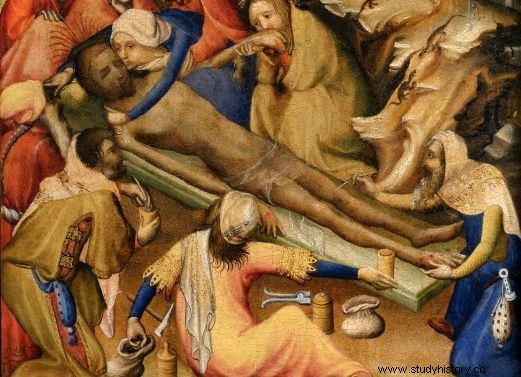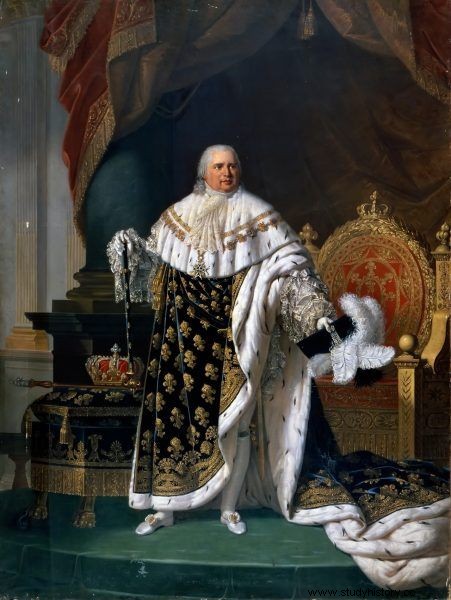Techniques to keep the body of a deceased (relatively) intact have been perfected since antiquity - with excellent results. But the embalming of the kings of France had a slightly different purpose. And other methods ...
Although the French kings were buried in the Christian spirit, the specialists of that time (not doctors - more on that later) drew full handfuls of the knowledge of the ancient Egyptians. "The body of the King of France, crowned head of state, secular and religious dignity, and heirs of Saint Louis, was traditionally protected from decay in anticipation of the Church's promised resurrection ”- writes Philippe Charlier in the book What do the dead teach us . It was mainly about stopping decay while the corpse was exposed to the public.
Deceased gutted
Before embalming methods were developed, funerals - even the funerals of kings - had taken place in a certain rush. It was important not to show a wider audience the body that is starting to decompose. As we read in "The Royal Funeral Ceremony in Renaissance France":
The reason seems simple enough:the embalming was rough, so the funeral was quick. These facts are interdependent, so when the former changed, so did the latter.
Thus, the greatest advancement in embalming in the early Middle Ages, gutting, occurs at the same time that funeral ceremonies have increased […]. The entrails were pulled out and immediately buried; preservatives such as salt and flavors have been used to protect the body, which were finally wrapped in fabric or leather […] and transported to the cemetery.

Techniques to keep the body of a deceased person (relatively) intact have been perfected since antiquity
Later, the whole procedure evolved, the people responsible for its implementation changed, and newer specifics were used to prepare the monarch to leave the other world ...
Marinated corpse
The oldest known case of an embalmed king of France is Philip I, who died in 1108. He was buried - unlike other rulers of the country on the Loire - in Saint-Benoît-sur-Loire. Interestingly, at first the process of preserving the body was taken care of by ... court cooks! It was up to them to cut open, drain the blood and fill them with the appropriate materials.
It was only later that these duties were gradually taken over by surgeons, supported by people who knew various substances:pharmacists and chemists. Doctors, in general terms, considered embalming to be work far below their competence. Philippe Charlier describes the whole procedure:
Cotton balls were stuffed into eyes, mouth, nose and ears. The body was then filled with numerous balsamic substances to prevent decay and mask unpleasant odors.
For this purpose, cypress bark, lavender, thyme, sage, rosemary, salt, pepper, wormwood, balsamic resin, myrrh, oregano, cinnamon, dill, cloves were used, among others , lemon zest, anise and incense. The provided body was sewn up and it could be exposed to the public.

Death of Louis IX.
The cooking skills also came in handy when King Louis IX died far from home - in Tunis. In order to somehow transport his remains, Ludwik was cut into pieces and cooked - so that the body departed from the bones. The skeleton went back to Saint-Denis. The smaller relics were to remain in Tunis, but their location is unknown today.
How alive
The main task of the embalmer was to bring the body to a state where it could be presented to the public. So the internal organs were removed and their condition was documented in search of any signs of disease or damage.
The body, heart and intestines were buried separately. The latter, which decompose most easily (including the eyes and tongue), were later stored in a sealed container in a coffin. A special reliquary contained a heart.
After filling the corpse with balsamic substances, the deceased was sewn up and exposed in this form for inspection. Some kings and queens wished before their deaths to make an exception for them and refrain from any part of the procedure. For example, Anna of Austria forbade taking anything but the heart out of her.
For elites only
Keeping the body in good condition had a very significant spiritual dimension. In this way, the ruler wanted to travel to eternity, avoiding the darkness of decay consuming "ordinary people." The procedure was also expensive, so only the powerful could pay for it - which heightened the exaltation of those in power.
Another important issue related to the embalming process was confirming identity and stating the causes of death . From the time of King Charles IX, this was the task of the dean of the medical faculty, who performed an autopsy in the presence of the deceased monarch's closest service. At the same time, the medic was preparing the corpse for conservation - but not doing it himself.

Louis XVIII is the only king buried after the Great Revolution who still rests peacefully in the basement of Saint-Denis.
The beginning of the end of the embalming custom is probably the case of Louis XV. The tradition was abandoned by an unfortunate coincidence:the king died of chickenpox, which posed a serious risk of infecting the autopsy and embalming people. The deceased was then wrapped in protective bandages and transferred to Saint-Denis at night. Such a desacralisation of the burial of the monarch must have been unheard of for the people of that time.
The last autopsied and embalmed king of France was Louis XVIII, who died in 1824. Completely new measures were used:Labarraque used a soda solution to get rid of unpleasant odors and to fill the body with organs removed - a mixture of various chemicals. Interestingly, Louis XVIII is the only king buried after the Great Revolution who still rests peacefully in the basement of Saint-Denis.
Bibliography:
- Brown, Elizabeth A., R., Authority, the Family, and the Dead in Late Medieval France . French Historical Studies, 1990.
- Charlier, P., What do the dead teach us. Esprit, Krakow, 2015.
- Colin, J., The Great Nation:France from Louis XIV to Napoleon (1715-1799) . 2002.
- Giesey, R., E., The Royal Funeral Ceremony in Renaissance France . Librairie E. Droz, Geneve, 1960.
- Le Goff, J., Saint Louis . Warsaw, Volumen, 2001.
- Rostworowski, E., Universal history. XVIII century . Scientific Publishers PWN, publishing house XI, Warsaw, 2004.
